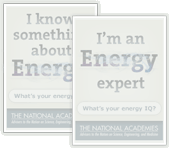
What You Need To Know About Energy
What do you know about energy?
How are battery electric vehicles and hybrid vehicles different?
- Battery electric vehicles receive charge from the electric grid, and hybrid vehicles do not.
- Hybrid vehicles have a gasoline engine and an electric motor that can supplement drive. Battery electric vehicles only have an electric motor.
- Hybrid vehicles consume petroleum onboard when the battery is exhausted. Battery electric vehicles do not consume petroleum onboard.
- Battery electric vehicles emit no carbon dioxide. Hybrid vehicles do emit carbon dioxide
- C and D
-
Sorry, that’s incorrect.
Battery electric vehicles have only a motor and battery, they recharge from the grid and their carbon emissions depend on the energy used to generate the electricity they use. Hybrid vehicles have both a gasoline engine and an electric motor, and use petroleum onboard when their batteries are exhausted. Some hybrid vehicles can charge from the grid and others cannot.
-
Sorry, that’s incorrect.
Battery electric vehicles have only a motor and battery, they recharge from the grid and their carbon emissions depend on the energy used to generate the electricity they use. Hybrid vehicles have both a gasoline engine and an electric motor, and use petroleum onboard when their batteries are exhausted. Some hybrid vehicles can charge from the grid and others cannot.
-
Sorry, that’s incorrect.
Battery electric vehicles have only a motor and battery, they recharge from the grid and their carbon emissions depend on the energy used to generate the electricity they use. Hybrid vehicles have both a gasoline engine and an electric motor, and use petroleum onboard when their batteries are exhausted. Some hybrid vehicles can charge from the grid and others cannot.
-
Sorry, that’s incorrect.
Battery electric vehicles have only a motor and battery, they recharge from the grid and their carbon emissions depend on the energy used to generate the electricity they use. Hybrid vehicles have both a gasoline engine and an electric motor, and use petroleum onboard when their batteries are exhausted. Some hybrid vehicles can charge from the grid and others cannot.
-
Correct!
Battery electric vehicles have only a motor and battery, they recharge from the grid and their carbon emissions depend on the energy used to generate the electricity they use. Hybrid vehicles have both a gasoline engine and an electric motor, and use petroleum onboard when their batteries are exhausted. Some hybrid vehicles can charge from the grid and others cannot.
How efficient are ordinary commercial solar cell units?
-
Sorry, that’s incorrect.
As of 2014, the very best experimental units could convert more than 40% of light energy to electricity; ordinary commercial units are in the range of 5% to 20%.
-
Sorry, that’s incorrect.
As of 2014, the very best experimental units could convert more than 40% of light energy to electricity; ordinary commercial units are in the range of 5% to 20%.
-
Correct!
As of 2014, the very best experimental units could convert more than 40% of light energy to electricity; ordinary commercial units are in the range of 5% to 20%.
-
Sorry, that’s incorrect.
As of 2014, the very best experimental units could convert more than 40% of light energy to electricity; ordinary commercial units are in the range of 5% to 20%.
What is the commonly accepted unit of measurement for electric current—or the amount of an electric charge passing a point per unit time?
-
Sorry, that’s incorrect.
The ampere, or amp, is the most commonly used measurement for electric current.
-
Sorry, that’s incorrect.
The ampere, or amp, is the most commonly used measurement for electric current.
-
Correct!
The ampere, or amp, is the most commonly used measurement for electric current.
-
Sorry, that’s incorrect.
The ampere, or amp, is the most commonly used measurement for electric current.
The United States is home to how many of the world's automobiles?
-
Sorry, that’s incorrect.
With less than 5% of the world's population, the United States is home to one-third of the world's automobiles.
-
Correct!
With less than 5% of the world's population, the United States is home to one-third of the world's automobiles.
-
Sorry, that’s incorrect.
With less than 5% of the world's population, the United States is home to one-third of the world's automobiles.
Which renewable energy source contributed the most to the total energy consumed in the United States in 2014?
-
Sorry, that’s incorrect.
Wood and waste biomass, along with biofuels, accounted for about 50% of the U.S. renewable energy supply in 2014, and more than 4% of all energy consumed.
-
Sorry, that’s incorrect.
Wood and waste biomass, along with biofuels, accounted for about 50% of the U.S. renewable energy supply in 2014, and more than 4% of all energy consumed.
-
Correct!
Wood and waste biomass, along with biofuels, accounted for about 50% of the U.S. renewable energy supply in 2014, and more than 4% of all energy consumed.
-
Sorry, that’s incorrect.
Wood and waste biomass, along with biofuels, accounted for about 50% of the U.S. renewable energy supply in 2014, and more than 4% of all energy consumed.
On average, which is most efficient in coverting heat into electic power?
- Coal boiler power plant
- Natural gas-fired turbine power plant
- Natural gas combined-cycle power plant
-
Sorry, that’s incorrect.
On average, a typical coal-burning power plant in 2013 was about 33% efficient in converting heat energy into electrical power. A gas-fired plant was about 42% efficient. And in natural gas combined-cycle power plants—in which waste heat from a natural gas turbine is used to power a steam turbine—generation may be as much as 60% efficient.
-
Sorry, that’s incorrect.
On average, a typical coal-burning power plant in 2013 was about 33% efficient in converting heat energy into electrical power. A gas-fired plant was about 42% efficient. And in natural gas combined-cycle power plants—in which waste heat from a natural gas turbine is used to power a steam turbine—generation may be as much as 60% efficient.
-
Correct!
On average, a typical coal-burning power plant in 2013 was about 33% efficient in converting heat energy into electrical power. A gas-fired plant was about 42% efficient. And in natural gas combined-cycle power plants—in which waste heat from a natural gas turbine is used to power a steam turbine—generation may be as much as 60% efficient.
In 2014, approximately how much of the oil used in the U.S. was imported?
-
Sorry, that’s incorrect.
The United States imported approximately 27% of its oil. More than one-third of that came from Canada.
-
Correct!
The United States imported approximately 27% of its oil. More than one-third of that came from Canada.
-
Sorry, that’s incorrect.
The United States imported approximately 27% of its oil. More than one-third of that came from Canada.
-
Sorry, that’s incorrect.
The United States imported approximately 27% of its oil. More than one-third of that came from Canada.
True or False: Burning coal in electric power plants is a major source of CO2 and other emissions. However, its use doesn't have negative consequences beyond the emissions caused by combustion.
-
Sorry, that’s incorrect.
Mining coal disturbs the land and modifies the chemistry of rainwater runoff, which in turn affects stream and river water quality.
-
Correct!
Mining coal disturbs the land and modifies the chemistry of rainwater runoff, which in turn affects stream and river water quality.
Which of the following energy sources releases carbon dioxide when burned?
-
Sorry, that’s incorrect.
Gasoline, diesel fuel, and natural gas all release CO2 when burned.
-
Sorry, that’s incorrect.
Gasoline, diesel fuel, and natural gas all release CO2 when burned.
-
Sorry, that’s incorrect.
Gasoline, diesel fuel, and natural gas all release CO2 when burned.
-
Correct!
Gasoline, diesel fuel, and natural gas all release CO2 when burned.
Thank you for taking our quiz.
Place this badge on your facebook page to show your friends what you know about energy.
Place this badge on your facebook page to show your friends what you know about energy.
Place this badge on your facebook page to show your friends what you know about energy.
Explore Other Topics
Energy Hands-on
Understanding Efficiency
Learn the significance of energy efficiencyThe Promise of Better Lighting
Energy savings through lighting technologyOur Energy System
A visualization of all our energy sourcesEnergy Defined
- Light-Emitting Diode (LED)
A device composed of a semiconducting material that emits light upon the application of an electric current. LEDs produce light from electricity more efficiently than either compact fluorescent lights or incandescent lights.




